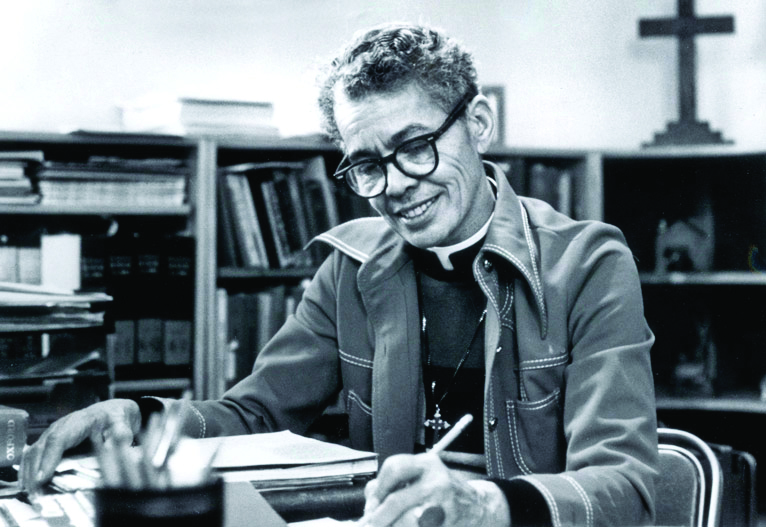She wore many faces — an unabashed feminist, legal scholar, civil rights activist, prolific writer, Episcopal priest and more. Pauli Murray was a multifaceted, multihyphenate revolutionary in American history, and yet, few say nor remember her name — let’s change that.
Anna Pauline “Pauli” Murray was born Nov. 20, 1910, in Baltimore but was raised in Durham by her aunts and grandparents. The granddaughter of a slave and great-granddaughter of a slave owner, Murray was a fair-skinned Black girl living in the deep South. She witnessed Jim Crow laws — segregated streetcars, lunch counters, movie theaters and schools. Once Murray learned the system, she began actively resisting it by walking to school and boycotting theaters.
In 1926, Murray graduated at the top of her class from Hillside High School and set her sights on Columbia University. But, to her dismay and frustration, Murray soon learned that Columbia did not accept women. Murray persisted in her goal to move north and looked to Hunter College, a women’s college in New York. However, Black high schools in North Carolina, such as Hillside, only went to 11th grade and did not offer the credits Murray needed to attend Hunter. Determined, she moved to Queens, New York, with her cousin and attended Richmond Hill High School where she was the only Black student out of 4,000.
As a child, Murray experimented with names like Paul, Pete and Dude. While at Hunter, she settled upon “Pauli” to better reflect her gender identity. Perceived as a woman, Murray endured a lifelong
struggle with her gender and attraction to women in a heteronormative society. Non-binary, transgender and other umbrella terms for people with non-conforming gender identities did not enter American vocabulary until the 1960s. Thus, in the words of her aunt, Pauli was a “little boy-girl.”
Rocking a short haircut and pants, Pauli traversed New York in the midst of the Harlem Renaissance. Along the way, she encountered fellow revolutionaries such as Langston Hughes, W.E.B. DuBois and
A. Phillip Randolph.
In 1933, she graduated from Hunter College with a degree in English literature during another significant period in U.S. history — the Great Depression. In and out of jobs, Murray briefly worked with the National Urban League and the Workers Progress Administration where she learned about the labor movement which she would later be a part of.
In 1938, Pauli Murray applied to UNC-Chapel Hill to study sociology knowing that the university, like many other institutions, did not accept students of color. Six days later, she received a
letter from Chapel Hill that read “members of your race are not admitted to the University.”
In response to the letter of rejection and racism, she started a media campaign to enter the all-white graduate school. Murray petitioned the NAACP to sue the university and mailed a letter of frustration to first lady Eleanor Roosevelt. Although the NAACP was unable to assist her, the first lady wrote back with words of encouragement for Pauli to keep fighting the system.
Constantly constrained by labels of gender and race, Murray realized her passions lay in challenging the patriarchy and fighting the brutal systems of Black oppression.
“I’ve lived to see my lost causes found,” Murray said.
In 1940, Murray and her friend refused to move to the back of a segregated bus in Richmond, Virginia. She was arrested, jailed and swore she would never return. Yet, in 1941, Murray was back in Richmond on behalf of the Workers Defense League to raise money for a Black sharecropper, Odell Waller. Sentenced to death for shooting a white man he worked for, Waller’s claim of self-defense fell on the neglectful ears of an all-white jury. Murray fervently fought for Waller and gave an emotional speech to a crowd that included Thurgood Marshall and a Howard law professor. Encouraged by the two, she enrolled at Howard University’s law school in 1941 determined to destroy Jim Crow.
Pauli termed the dual plight of Black women “Jane Crow.” During her time at Howard, she led student protests including a sit-in at a segregated lunch counter in Washington, D.C. After graduating from Howard at the top of her class in 1944, Murray was denied post-graduate education at Harvard University because of her gender. She went to the University of California at Berkeley instead and
earned her master’s. In 1946, Murray became the Deputy Attorney General of California, making her the first African American in the state attorney general’s office. Soon after, she wrote “States’ Laws on Color and Race,” which Marshall referred to as the “bible” for lawyers working on civil rights cases such as Brown v. Board of Education.
Frustrated with the stagnant state of the civil rights movement, Murray briefly moved to Ghana in 1960 to teach law before returning to the U.S. to attend Yale Law School. While writing her thesis, Murray wrote an influential memorandum demanding that “sex” be included in the Title XII of the Civil Rights Act of 1964. In 1965, she became the first African American woman to receive a Doctor of Juridical Science from Yale. After graduating, Murray co-authored “Jane Crow and the Law: Sex Discrimination and Title VII.” The acclaimed essay was cited by Ruth Bader Ginsburg in her Supreme Court case, Reed v. Reed, which successfully challenged sex-based discrimination.
Murray went on to co-found the National Organization for Women, serve on the national board of the ACLU and taught on tenure at Brandeis University. After decades of activism, Murray knew that Jane Crow discrimination still existed both in the civil rights and women’s movements.
In 1973, following the death of her longtime partner Irene Burlow, Murray left Brandeis to become the first Black woman to serve as an Episcopal priest. On July 1, 1985, Murray died of cancer and her autobiography, “Song in a Weary Throat: An American Pilgrimage,” was published posthumously in 1987.
Originally Published 3/23/2023




